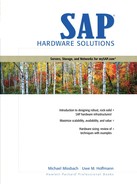Summary
There are many server, operating system, and database platforms supported by SAP software and the mySAP.com components. The choice of server, operating system, and database platform is not always one of cost. Sometimes performance requirements are the most critical, other times the integration with IT operations practices is the most important to help reduce the total cost of ownership. Some of the following important points were made in this chapter:
When choosing multiple OS platforms to run SAP systems, it is important to get hardware vendor support for the OS across all the critical server systems.
Performance differences between operating systems (Unix, Linux, and Windows NT/2000) and databases are not expected to be a significant sizing factor once the hardware platform is the same. SAP tries to make its software database and OS platform independent as much as possible, so it cannot take advantage of proprietary OS and DB features. Thus the OS and DB choices should be based more on other factors, such as management, recovery and HA solutions, established IT procedures and training, reliability, and other nonperformance related factors.
Implementing the same SAP system across two different OS platforms usually adds complexity. However, the heterogeneous SAP environment may be interesting when SAP administration skills are available across both OS platforms.
Processors are continually getting faster. Some SAP batch processing environments require the fastest processors possible due to limitations in making the jobs parallel.
SMP systems are the ideal choice for SAP application servers. For SAP R/3 (OLTP) database servers, consider using SMP systems with crossbar architectures.
The newer ccNUMA architecture promises to be more scalable than standard SMP systems, however, they require optimized software to see the benefits. Consider these systems first in data warehousing environments.
SAP application memory requirements are steadily growing with each release. Choose a 64-bit solution, whenever possible, for all components, including the SAP application, the database, and the operating system.
On the Microsoft Windows NT/2000 IA-32 platform, a very large memory (VLM) workaround is possible for some database platforms.
To help reduce implementation costs, choose a server platform vendor that has experience with 64-bit SAP environments before upgrading or performing a migration.
To address larger memory, 64-bit I/O adapters are needed. Database servers need many I/O slots to handle the redundant adapters, and lots of I/O bandwidth.
Choose a server platform that helps keep the implementation and ongoing costs low.
Consolidating multiple SAP systems (DB and application instances) on a fewer number of servers may be an attractive practice for several reasons.
